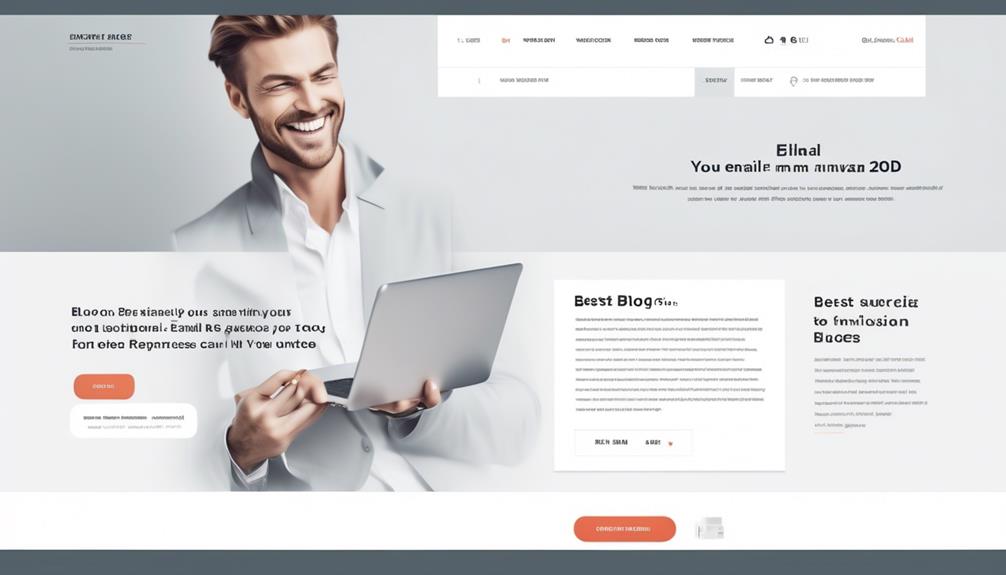Email continues to be a crucial tool for marketing, and it’s essential to note that a recent survey found that 73% of millennials prefer engaging with companies via email.
In today’s digital landscape, staying ahead of email design trends is crucial for effective engagement and conversion. Whether you’re a seasoned marketer or a budding designer, understanding the latest trends and techniques can elevate your email campaigns to new heights.
In the ever-evolving world of email design, knowing how to captivate your audience and drive action is paramount.
So, what are the key trends shaping email design in 2024, and how can you leverage them to craft compelling campaigns that stand out in overflowing inboxes?
Key Takeaways
- Email design is crucial for marketing success in the digital landscape.
- Visual layouts tailored to specific purposes enhance engagement.
- Interactive elements in email designs increase user interaction.
- Compelling campaigns include clear objectives, emotional visuals, and persuasive language.
Importance of Email Design
The importance of email design can’t be overstated in today’s competitive digital landscape, where capturing and retaining audience attention is paramount for marketing success. Effective email design advocates brand identity, engages the audience, and leaves a long-lasting impression, providing a robust foundation for marketing strategies.
It resonates with the target audience, capturing their attention and fostering a compelling user experience. Good email design creates a ‘wow’ effect, turning users around with marketing tricks and showcasing products or services effectively.
Furthermore, it’s crucial to consider the click-through rate (CTR) and the alignment of emails with marketing goals. Evaluating existing emails and identifying areas for improvement is essential for enhancing the impact of email campaigns.
Utilizing email marketing software to create engaging HTML email templates is a fundamental aspect of successful email design. Engaging emails not only boost brand awareness and nurture the target audience but also contribute to increased conversions and sales.
Types of Email Designs
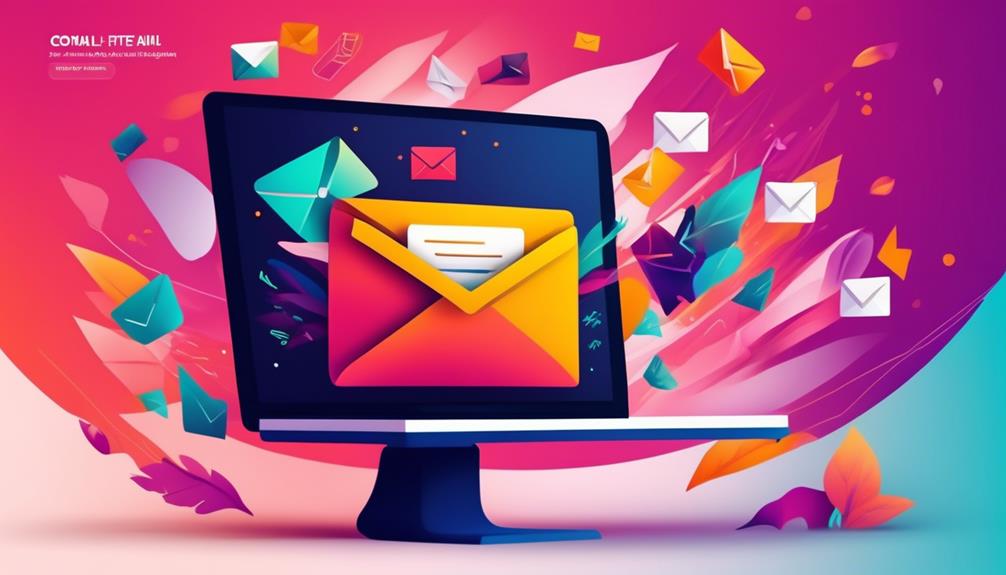
Let’s explore the visual layouts and interactive elements that are transforming email designs.
These elements are key to capturing and holding the attention of recipients.
Visual Layouts
When crafting email designs, it’s essential to consider the various types of visual layouts, each tailored to specific purposes such as:
- Re-engaging potential customers
- Providing regular updates
- Leveraging customer loyalty
Visual layouts encompass a wide range of email designs, including:
- Cart abandonment
- Newsletters
- Holiday-themed
- Digital products
- Sales
- Testimonial/review emails
Cart abandonment emails are auto-generated and aim to re-engage potential customers. Newsletters provide regular updates about products, services, and content. Holiday emails capture the essence of holidays to incentivize purchases. Emails for digital products focus on compelling customers to make digital purchases. Sales emails offer exclusive discounts. Testimonial/review emails ask for feedback to leverage customer loyalty.
Utilizing HTML, design elements, and brand identity is crucial in creating visually appealing email designs for 2024.
Interactive Elements
Utilizing interactive elements in email designs enhances user engagement and interaction within the email itself. This can lead to higher click-through rates and provide valuable insights into user preferences and behavior.
Interactive emails can feature various elements such as quizzes, polls, surveys, image carousels, and product galleries. These elements encourage recipients to actively participate and increase their engagement with the email.
Incorporating a dynamic content section or personalized call-to-action button can also elevate the user experience and drive conversions.
However, it’s important to note that fake interactivity using misleading elements should be avoided. This can harm brand credibility and negatively impact the user experience.
Successful email design examples include gamified content, live social media feeds, and personalized product recommendations. These elements contribute to a more engaging and impactful email marketing strategy.
As email design trends continue to evolve, the strategic integration of interactive elements becomes crucial for maximizing user interaction and campaign effectiveness.
Key Elements for Compelling Campaigns
To create compelling email campaigns, a clear and compelling objective should be evident from the start of the email. This objective sets the tone for the entire campaign and helps to guide the design and content creation process.
When aiming to evoke emotion in the audience, consider incorporating the following elements:
- Visuals: High-quality images and videos can evoke strong emotional responses and help to convey the brand’s message effectively.
- Subject Lines: Craft compelling subject lines that pique curiosity, create a sense of urgency, or offer personalized value to the recipient.
- CTA Buttons: Use persuasive language and compelling design for CTA buttons to prompt action from the audience.
Best Practices for Email Design
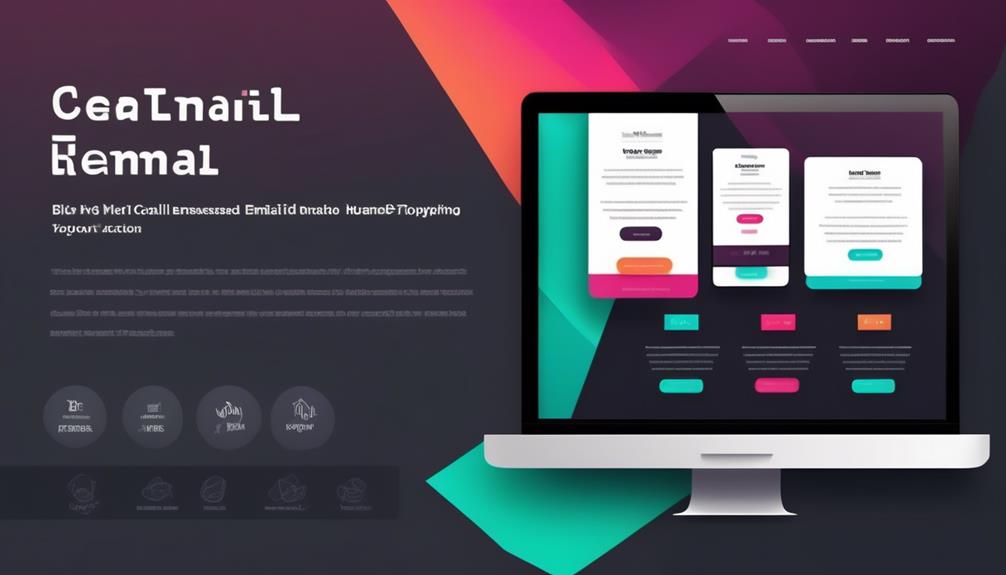
After establishing the key elements for compelling email campaigns, seamlessly implementing best practices for email design is essential to ensure the message is effectively conveyed and resonates with the audience.
As we delve into the best practices for email design, it’s crucial to craft an attention-grabbing subject line to optimize open rates. Maintaining on-brand design elements such as logos, colors, and fonts creates a cohesive and professional look that aligns with your brand identity.
Keeping the email design simple, clean, and focused ensures that the recipient can easily digest the content without feeling overwhelmed. Additionally, including a strong Call-to-Action (CTA) encourages recipients to engage with the email content, whether it’s making a purchase, signing up for an event, or accessing exclusive content.
Utilizing separators and white space within the email layout helps to give the content room to breathe and makes the email more visually appealing. These best practices for designing emails contribute to creating unique and impactful email designs that resonate with your audience, ultimately leading to higher engagement and conversions.
Popular Email Design Tools
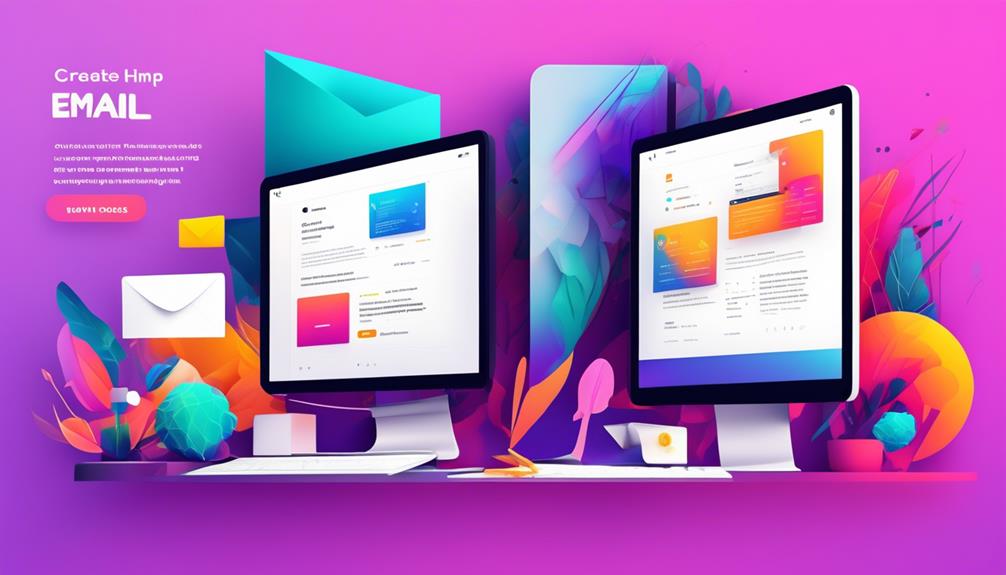
We can leverage popular email marketing software tools like Mailchimp, Constant Contact, and SendinBlue to create compelling email designs. These tools offer a range of features for designing custom email templates, including responsive emails and typography in email design.
Additionally, dedicated email design tools such as Stripo, Chamaileon, and BeeFree provide advanced capabilities for creating unique and visually appealing email templates.
For those looking to create custom email designs from scratch, Adobe InDesign, VivaDesigner, and Scribus, along with HTML with inline CSS, offer powerful options to design highly personalized emails.
Moreover, Postcards Email Builder stands out as an easy-to-use tool for designing various types of emails, including promotional, e-commerce, news, and transactional emails.
With these email design tools at our disposal, we can craft visually stunning and impactful email campaigns that resonate with our audience.
High-Converting Email Design Examples

Let’s explore some high-converting email design examples that showcase effective visual appeal tips, call-to-action strategies, and personalization techniques.
These examples will provide practical insights into creating engaging and action-driving email designs. By analyzing these successful examples, we can gain valuable inspiration for improving our own email design strategies.
Visual Appeal Tips
Improving the visual appeal of emails can significantly enhance reader engagement and click-through rates, ultimately contributing to the achievement of marketing objectives.
To create visually appealing emails, we can use captivating designs that grab the reader’s attention and pique their interest. Incorporating a variety of colors and visuals can make the email more visually stimulating and engaging.
Additionally, using white space and separators can create a clean and organized look while allowing the content to breathe. By making the text easy to read and visually appealing, it can enhance the overall design and make the email more compelling.
Stand out from other marketing emails by creating a unique and creative design that resonates with the audience.
Call-To-Action Strategies
Crafting compelling call-to-action (CTA) strategies is essential for creating high-converting email designs. Email marketers must strategically employ persuasive language and position the CTA prominently within the email templates to prompt recipient engagement.
Utilizing color psychology in email design can also significantly impact open rates, with contrasting colors and eye-catching design elements drawing attention to the CTA.
Personalizing and tailoring CTAs to specific recipient segments or behaviors can further enhance their relevance and effectiveness.
A/B testing different CTA variations is crucial for optimizing conversion rates, allowing email marketers to identify the most effective strategies for prompting recipient action.
Personalization Techniques
Utilizing personalized subject lines and dynamic content tailored to recipient behavior and preferences, we can create high-converting email designs that resonate with individual recipients. Personalization techniques are essential in enhancing email design trends for 2024 and maximizing marketing efforts.
Here are three key personalization techniques to evoke emotion in the audience:
- Addressing recipients by name and incorporating relevant details in subject lines.
- Tailoring email content based on recipient behavior, preferences, and past purchase history.
- Implementing location-based personalization to promote local events or deals.
Designing for Dark Mode

Designing for Dark Mode presents a unique challenge in ensuring consistent rendering and appearance across various email clients, especially in low-light or nighttime environments. As we move into 2024, the popularity of dark mode continues to rise, making it essential for email designers to optimize their emails for this setting.
Dark mode’s darker color palette can have a significant impact on the visuals and colors used in emails. It’s crucial to carefully consider the use of colors and visuals to ensure that emails are legible and visually appealing in both light and dark modes. Optimizing for dark mode isn’t only about adjusting colors, but also about ensuring that the overall design and layout remain visually effective for readers.
Additionally, some email clients may not automatically adjust the appearance of HTML emails in dark mode, emphasizing the need for intentional design considerations. By prioritizing dark mode optimization, email designers can enhance the readability and overall user experience of their emails.
Crafting Strong Subject Lines

To capture the recipient’s attention, we employ concise and compelling language in our subject lines, enhancing the likelihood of email opens. Crafting strong subject lines is essential for engaging our audience and driving open rates.
To achieve this, we incorporate personalization and urgency, evoking a sense of exclusivity and prompting immediate action. Additionally, we steer clear of spam trigger words and excessive punctuation, ensuring that our emails bypass spam filters and reach the recipient’s primary inbox.
Lastly, we continuously test different subject lines to gauge their effectiveness, optimizing open rates and refining our approach. By considering the audience’s preferences and behavior, we tailor subject lines to align with their interests, fostering a deeper connection and resonating with their emotions.
Staying On-Brand

When it comes to email design, staying on-brand is crucial. Consistent use of brand elements such as logos, colors, and fonts helps maintain brand identity and recognition.
We also need to ensure that the email design reflects our brand’s image and messaging to reinforce brand recognition.
Brand Consistency
Maintaining brand consistency in email design is essential for reinforcing brand identity and fostering a cohesive brand experience.
To achieve this, we prioritize the following elements:
- Consistently using brand colors, logos, and fonts to evoke familiarity and trust.
- Ensuring the email design aligns with the overall brand image and messaging, creating a seamless brand experience.
- Using brand-specific imagery and visual elements that reflect the brand’s identity, enhancing recognition and engagement.
Visual Identity
Ensuring brand consistency in email design is crucial for creating on-brand email designs that resonate with our audience. We emphasize the visual identity that reflects our brand’s personality and values. By incorporating brand-specific design elements, such as logos and color palettes, into our email designs, we ensure alignment with our overall brand image.
In 2024, email design trends continue to prioritize on-brand visuals, colors, and font choices. Adhering to visual identity guidelines is crucial for creating on-brand email designs that resonate with our audience. Our email design shouldn’t only be visually appealing but also reflect our brand’s personality and values.
Tone and Voice
To maintain a consistent and recognizable brand image, it’s imperative to establish a tone and voice that authentically embodies our brand’s personality and resonates with our target audience. When crafting our email content, we must ensure that the language and messaging used align with our brand’s identity and values.
Incorporating brand-specific phrases, humor, or storytelling techniques can help maintain a cohesive and recognizable voice in our emails. It’s also essential to regularly review and refine our email content to ensure it stays on-brand and effectively represents our brand’s identity.
By doing so, we can evoke the desired emotions and connections with our audience, ultimately driving engagement and loyalty.
- Use language that resonates with our audience
- Infuse humor and storytelling techniques
- Regularly refine and review our email content
Engagement Strategies

By tailoring the content to match recipients’ preferences and behavior, we can significantly enhance engagement in email marketing campaigns. Personalizing the email design to cater to individual preferences and behavior ensures that the content resonates with the audience, capturing their attention and driving interaction.
Incorporating a strong Call-to-Action (CTA) strategically within the email newsletter prompts recipients to take action, boosting engagement and response rates.
Utilizing interactive features and elements in the email design captivates the audience, encouraging them to further engage with the content and ultimately driving conversions.
A/B testing and thorough analysis of metrics help optimize the email design for better engagement and response rates, ensuring that the design best captures readers’ attention and prompts desired actions.
Additionally, ensuring that the email design is fully responsive and mobile-friendly is essential to engage recipients who access their emails through various email clients and devices.
Leveraging dark mode targeting methods further enhances engagement by optimizing the email design for recipients who prefer using dark mode.
Content Layout and Structure

As we focus on Content Layout and Structure, seamlessly integrating personalized elements into the design can further enhance engagement in email marketing campaigns.
When optimizing email content layout and structure, consider the following key strategies:
- Utilize a clear and structured layout to guide the reader’s eye and improve readability.
- Incorporate white space and separators to create visual hierarchy and give content room to breathe.
- Organize content with headings, subheadings, and bullet points for easy scanning and comprehension.
Mobile Responsiveness
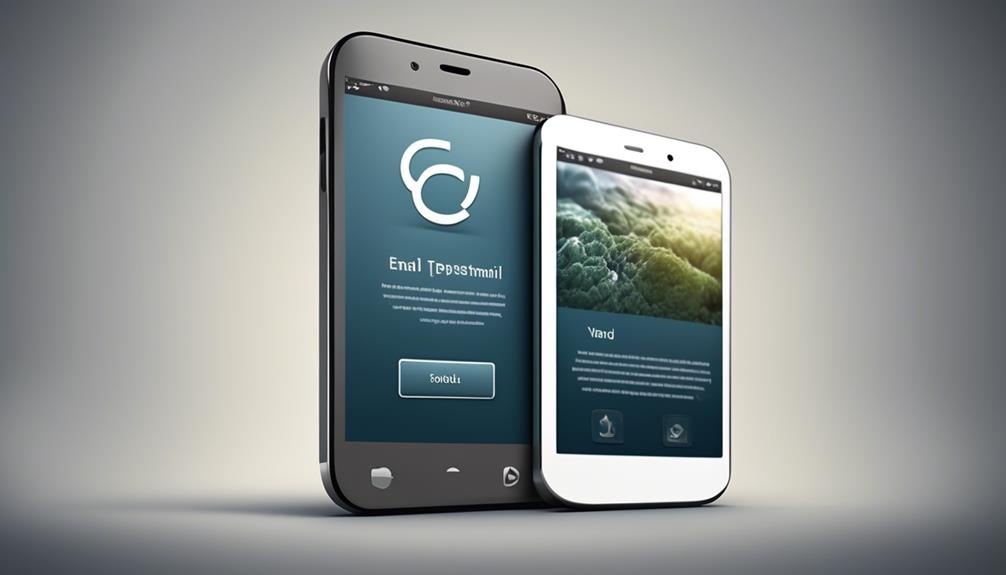
Mobile responsiveness in email design plays a crucial role in ensuring a seamless user experience across various devices. With the increasing use of mobile devices to access emails, prioritizing mobile responsiveness is essential. It’s important to test email designs on different devices to ensure optimal display on various screen sizes.
Utilizing responsive design techniques, such as HTML and center alignment, allows for automatic adjustment of layout and content based on the device being used. This ensures that all readers, regardless of the devices they use, have a positive experience with the email content.
Implementing mobile responsiveness not only improves user engagement but also enhances click-through rates on mobile platforms. By focusing on mobile responsiveness and writing clean, adaptable code, email designers can effectively reach and engage with their audience across different devices.
Personalization Techniques
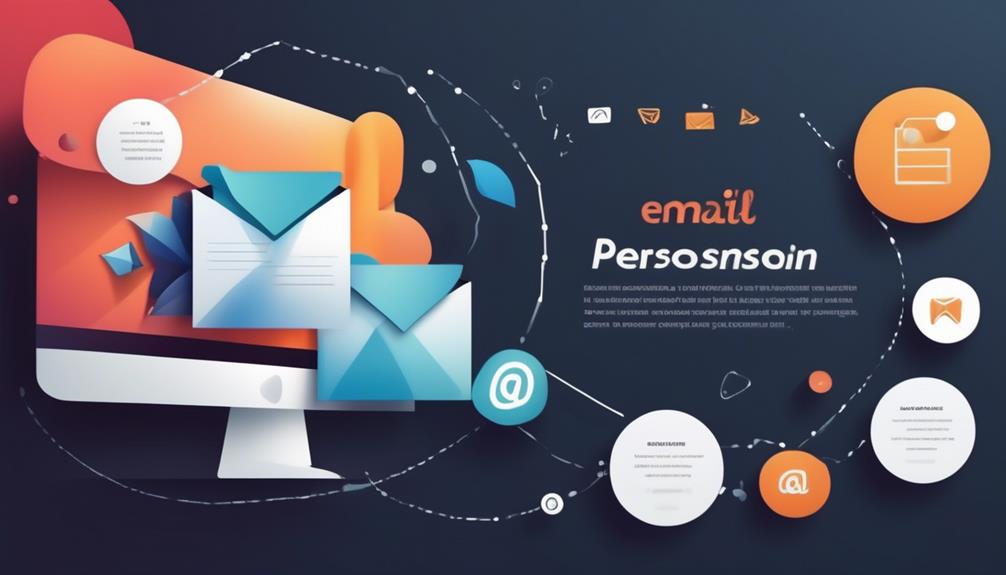
With the increasing use of mobile devices to access emails, prioritizing mobile responsiveness, the implementation of personalization techniques becomes crucial in tailoring content to individual recipients based on their preferences and behavior.
Utilizing dynamic content to deliver personalized product recommendations and offers can create a sense of exclusivity and relevance for email users. Implementing A/B testing to optimize personalized content and messaging can evoke a sense of curiosity and excitement in the audience, as they anticipate unique and tailored experiences.
Leveraging segmentation to target specific audience groups with personalized email campaigns can make email users feel understood and valued, fostering a sense of loyalty and connection. By incorporating personalization tokens to insert recipient-specific information, such as names or locations, into the email content, a sense of individual importance and recognition is conveyed, enhancing the overall impact of the email copy.
These personalization techniques, when integrated seamlessly into email design and HTML, can create a cohesive and captivating experience, ultimately leading to higher conversion email rates.
Accessibility Considerations

Considering the diverse needs of email users, it is imperative to ensure that all elements of the email are accessible to individuals with disabilities. When designing emails, it’s crucial to consider accessibility to accommodate users relying on screen readers or those with visual, cognitive, or motor impairments. Here are some key accessibility considerations for email design:
| Accessibility Considerations | Description |
|---|---|
| High Contrast Colors | Use colors with a high contrast ratio to improve readability for visually impaired users. |
| Alternative Text for Images | Provide descriptive alternative text for images to ensure that visually impaired users can understand the content. |
| Keyboard Accessible Interactive Elements | Ensure that interactive elements such as buttons and links are easily accessible via keyboard navigation. |
| Clear and Concise Content | Use clear headings and structured content to aid navigation for individuals with cognitive disabilities. |
In addition to these considerations, email designers should also ensure that their emails are compatible with email readers and can be easily understood when viewed as plain text. Regular accessibility audits and testing should be conducted to ensure compliance with WCAG guidelines and standards, providing an inclusive experience for all users.
A/B Testing Strategies

To optimize email performance, we employ A/B testing strategies to refine subject lines, CTAs, designs, and content personalization for enhanced audience engagement. A/B testing is a powerful tool that allows us to make data-driven decisions to improve our email design.
Here are three tips to make your emails stand out in 2024:
- Test different subject lines to evoke curiosity and drive open rates. Emphasize personalization and relevance to capture your audience’s attention.
- Experiment with various CTAs to elicit a sense of urgency or excitement, encouraging recipients to take action. Use compelling language and vibrant colors to make your CTAs irresistible.
- Test different email designs to create visually appealing layouts that align with your brand and resonate with your audience. Incorporate eye-catching visuals and interactive elements to enhance engagement.
Can I Use Your Ultimate How-To Guide to Implement the Top Email Design Practices for 2024?
Yes, you can absolutely use our Ultimate How-To Guide to implement the top email design practices for 2024. This guide will walk you through the latest trends and best practices that will help your emails stand out in the inbox and drive engagement with your audience.
Frequently Asked Questions
How Do I Customize My Email Design?
We customize email design by incorporating our brand elements, like logos and colors, for a consistent look.
We strategically use separators and white space to enhance readability and visual appeal.
Implementing a strong Call-to-Action encourages reader engagement.
Experimenting with email marketing software or custom design methods helps create a unique and impactful design.
This approach immediately engages readers and aligns with our brand identity for a compelling email design.
When Designing the Layout of Email Copy What Are the Email Design Best Practices You Need to Consider?
When designing the layout of email copy, we need to consider several best practices.
It’s crucial to ensure a clear objective from the start.
Grab the reader’s attention with captivating design.
Keep the layout simple and focused for enhanced readability.
Incorporating a strong Call-to-Action (CTA) strategically within the layout is important to drive user engagement.
Utilizing separators and white space effectively enhances visual appeal and readability.
What Should Be the Ideal Layout of an Email?
We aim for an email layout that grabs attention like a magnet! Our ideal design features:
- A clear objective
- Captivating visuals
- A clean, focused structure
We strategically place the Call-to-Action, incorporate separators and white space for readability, and maintain a creative flair to pique interest.
Our layout is simple, yet effective, ensuring our emails stand out and engage our audience.
What Are the Main Design Considerations When Crafting an Email?
When crafting an email, the main design considerations revolve around clarity, visual appeal, and alignment with the brand.
We focus on ensuring the email’s objective is immediately understood, using captivating visuals to grab attention, and evaluating existing emails for improvement.
We also prioritize the Click-Through Rate and create a clean, focused layout that stays true to our brand’s identity.
These elements combine to enhance the effectiveness and impact of our email marketing efforts.
Conclusion
In conclusion, the 2024 Email Design Trends guide offers valuable insights into creating compelling email campaigns.
Did you know that 80% of users delete emails if they don’t look good on their mobile device?
By following the latest trends, incorporating key elements, and utilizing the best practices outlined in the guide, you can optimize your email design and engage your audience more effectively.
Don’t miss out on the opportunity to enhance your email marketing strategy with these valuable tips!





